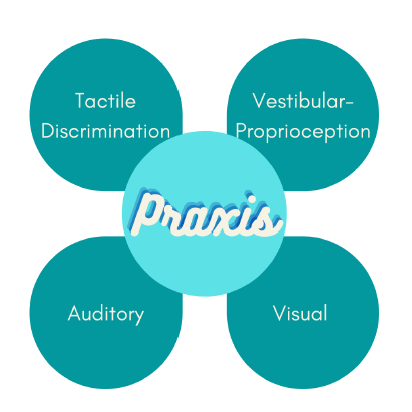What is Praxis?
When reading about sensory integration, you must have come across the term “praxis” or motor planning – which is defined as the ability to plan and carry out an unfamiliar action. Praxis enables people to ideate, plan, and executes a wide range of skills in a refined and efficient manner (Dodd, 2005). Praxis skills include everything from moving and sorting objects during infancy up to organizing their belongings when they’ve gone to school!

Praxis and Our Sensory Systems
Praxis is the most complex form of functioning in children. It is the result of the integration of multiple sensory systems occurring at the brainstem and cerebral hemispheres. Difficulties to integrate any of these sensory systems lead to difficulties in any activities requiring praxis skills such as daily living activities, social participation , and academic learning (Ayres, 2005). Listed below are the sensory systems crucial for praxis;
Tactile Discrimination – understanding boundaries of the body, providing precise information on how our body is moving in the environment & ongoing feedback for every action made
Vestibular-Proprioception – recognizing how fast/slow and the direction our body is moving or at rest, sensing weight and size
Visual – exploring opportunities in the environmentand providing feedback to the brain while performing actions
Auditory – important for spatial awareness and processing unfamiliar instructions

Dyspraxia
Take a few moments to think if any of the following statements fit your child;
Does your child…
- Appear clumsy or awkward?
- Dislike or avoid participating in sports or other physical activities?
- Have trouble coming up with new play ideas or knowing how to play with toys? Tend to always choose the same play structure or activities?
- Seems to do things in an inefficient way e.g. putting in extra or leaving out steps in activities?
- Show difficulties when transitioning from one activity to another? Have trouble organizing his desk or room?
- Seem “accident-prone” or have a tendency to bump into and/or trip over things?
- Take longer than other children to learn skills such as tying shoes, getting dressed, writing letters and numbers, or catching a ball?
- Act “bossy” with friends, sometimes appearing to direct activities so that he can control situations? (Ayres, 2005)
Even if a child has good motor skills, they can still have difficulties in motor planning and organizing action or dyspraxia. Dyspraxia or Developmental Coordination Disorder as recognized in the Diagnostic and Statistical Manual of Mental Disorders, Fifth Edition (DSM-5) is more than poor coordination skills, as the process of motor planning occurs at the neurological level indicating poor processing skills. A child with dyspraxia continues to do something as though it was their first time, every time. Tasks do not become readily or completely automatic for the child with dyspraxia, and they would consistently need help from adults to go about their day.
Helping your child develop their praxis skills
- Include more activities like messy play that encourages improvement of body awareness and sense of touch to help your child plan actions more effectively,
- Obstacle courses help your child to understand how to move their body through space.
- Break down activities into small and achievable tasks
- Activities that revolves around imitations skills such as Follow the Leader helps them to be able to plan actions from watching & copying others
- Have your child walk you through steps that need to be done to complete their daily activities such as showering, dressing themselves up, organizing their bedroom etc
- To learn more on how you can support your child’s praxis skills development, get in touch with our occupational therapists today!
Resources:
American Psychiatric Association. (2013). Diagnostic and statistical manual of mental disorders (5th ed.). Arlington, VA: Author.
Ayres, A. (2005). Sensory integration and the child. Los Angeles, CA: Western Psychological Services.
Dodd, S. (2005). Understanding autism. Sydney: Elsevier.





